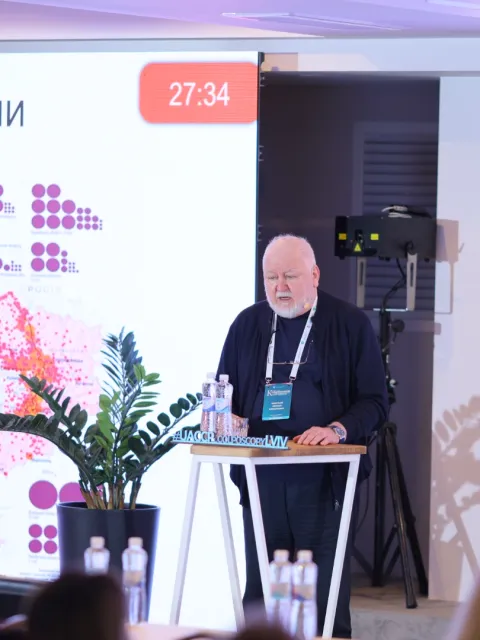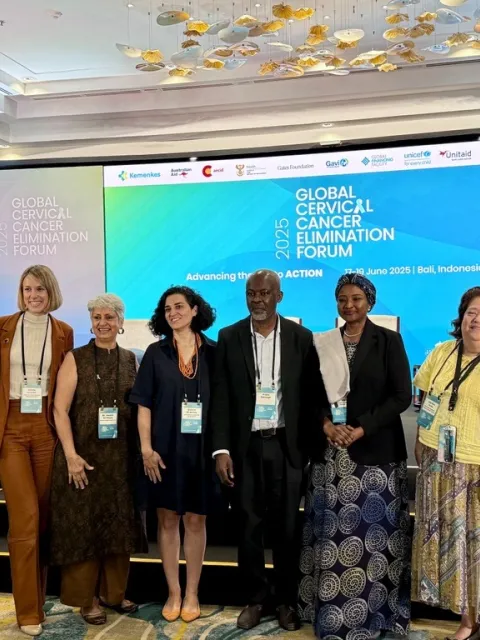Taskforce takes action to reduce the burden of cervical cancer in the Commonwealth
UICC Board Member, Dr Miriam Mutebi, offers an inside look at the efforts of the International Taskforce on Cervical Cancer Elimination in the Commonwealth to reach WHO’s targets.

The Commonwealth accounts for about 30% of the world’s population. However, this group of 54 disparate nations carries a disproportionate burden of cervical cancer: 36% of the number of cases and 39% of related deaths by 2030, figures that are expected to rise to 38% and 42% respectively by 2030, according to the statistics published in the Global Cancer Observatory.
The diverse nature of challenges faced by Commonwealth nations in addressing cervical cancer means that a one-size-all approach cannot work. However, there are many benefits to coordinating responses among the nations.
UICC resources and tools for cervical cancer
Access important resources on cervical cancer elimination, such as news articles, blogs, infographics, videos, documents and links.
For this reason, UICC and the Commonwealth Secretariat launched a new Taskforce in May 2021 to drive progress in achieving the “90:70:90” targets for 2030 set by the World Health Organization for cervical cancer elimination: fully vaccinate 90% of girls against HPV vaccine by the age of 15; screen 70% of women using a high-performance test by the age of 35, and again by the age of 45; and 90% of women with pre-cancer treated and 90% of women with invasive cancer managed.
Recognising the importance of collaboration in eliminating HPV and cervical cancer, the Taskforce has developed partnerships with allies from multiple sectors, government and NGOs.
The Chair of the International Taskforce on Cervical Cancer Elimination in the Commonwealth, Dr Miriam Mutebi, UICC Board Member, Consultant breast surgical oncologist and Assistant Professor in Surgery at the Aga Khan University, looks at the challenges and progress in the past year marked by the COVID-19 pandemic.
Dr Mutebi, what are the most urgent needs facing cervical cancer elimination in the Commonwealth?
Every year, our 54 countries carry both some of the highest cervical cancer rates in the world at close to 80 per 100,000 women and some of the lowest rate less than 10 per 100,000 women, with the African region shouldering the highest burden.
This disparity is largely driven by an inequitable access to prevention and treatment services for what is a highly preventable cancer, and treated with a high degree of success when detected early. It is also due to a lack of information about cervical cancer needed to fight stigma and misinformation about the disease.
What are some of the challenges for implementation in the Commonwealth?
Due to the diversity of the Commonwealth countries’ needs and resource levels, we cannot develop a one-size-fits-all approach; however, there are three major barriers to care that are common to many nations.
First, there is the fact that many prevention, diagnostic and treatment options for cancer are out-of-pocket, at the patient’s expense. And while the potential for financial toxicity is more accentuated in low- and middle-income countries, it can also lead to debt and bankruptcy i.e. catastrophic health expenditure, for certain populations also in high-income countries.
The second common barrier is the health systems. There is a lack of facilities, skilled workforce, infrastructure and supportive care services to manage cervical cancer. The lack of awareness among primary care physicians on the early signs and symptoms of cancer also causes delays – in sub-Saharan Africa, for instance, a patient may see on average three to four healthcare providers, before a definitive diagnosis of their cancer is made. And at that point, it is often diagnosed at advanced stages, when the disease is harder to treat. Geographical barriers also exist with patients having to cover long distances in order to reach the few cancer centres.
And the third major barrier are the social and cultural beliefs and practices in our communities. In many places, women are not the primary determinants of their health seeking behaviour, requiring a partner to provide financial support, or in some cases even permission, to access care. There is also stigma attached to reproductive cancers as well as judgment; for instance, a woman who gets cervical cancer may be perceived as having been sexually indiscriminate and therefore at fault. There may also be regional taboos on discussing female cancers, which then prevent a woman from seeking appropriate care. Many myths also exist around HPV vaccines where certain communities believe that vaccinating against HPV, gives a young adult the licence to be sexually promiscuous or that they cause infertility – which studies have clearly shown is not true.
What actions are being taken by the Taskforce towards elimination?
The Taskforce combines international expertise, Commonwealth Secretariat strengths and the advocacy voice of UICC’s global network of members to accelerate national action, with a focus on the 2030 targets in the WHO global strategy.
For countries transitioning from mostly communicable disease to mostly non-communicable diseases, cancer prevention and treatment will require buy-in from, and political oversight at, the highest levels of government.
At the policy level, for instance, we have secured a session at the next Commonwealth Heads of Government meeting in Rwanda that is intended to be reflective on how to build resilient systems. The pandemic has had the silver lining of opening up the opportunity to use existing services and infrastructure for COVID-19 (for example, PCR testing) to include cervical cancer, for instance PCR testing facilities for HPV vaccination. In this way, we can optimise care and utilise existing systems without significant additional investment.
We are also looking at leveraging regional strengths to benefit individual countries. Medicines, for instance, can actually cost much more in LMICs than in HICs, when the disposable income is so much lower. What we are working on through the taskforce is to collate data and look at shared costing. Some countries have access to better prices – how can other countries benefit from that? The idea is to obtain regionally competitive prices rather than allow each country to operate on its own, from a weaker position.
Since 2018, the Commonwealth's Secretariat has also worked to build a database of information about HPV vaccine costs and availability that will enable the Commonwealth to use pooled procurement – a single buyer making purchases for individual entities – and make these lifesaving drugs more affordable to its member countries.
However, facilitating access to vaccines and screening are not sufficient. Community education and social mobilisation are essential components of the comprehensive approach to prevention of cervical cancer recommended by WHO.
The Commonwealth represents potentially the world's richest source of research evidence in terms of genomic and topographical heterogeneity. The construction of an accessible online knowledge base of the cancer control research conducted within the Commonwealth is under active consideration by the Commonwealth Secretariat to raise awareness and fight ignorance. Gathering up this crucial information and making it more accessible to health professionals, community groups and the media will be as important to the campaign to eliminate cervical cancer as providing access to human papillomavirus vaccines.
There is also a youth branch of the Taskforce?
The Alliance for Active Action Against HPV (A4HPV) was formed in 2020 as the Commonwealth’s youth advocacy arm and they are doing incredible work. A4HPV has been crucial in getting young adults involved and demystifying cervical cancer, through innovative approaches, using TikTok challenges or a programme to deliver self-testing kits to homes, for instance.
Sometimes we think of elimination at the policy level and it is great to have the advocacy and youth movement bringing it down to the grass roots. Change begins with each of us, talking about the issue, talking about the stigma, having these conversations in the public spaces, goes a long way to breaking down the hidden barriers to care, which are sometimes the biggest.
What are the prospects for success at achieving the 90:70:90 targets for 2030?
We are quite positive about achieving them. We did take a hit with the pandemic – people have been coming into the hospital with advanced cancers because they stayed away from hospitals due to fears related to COVID-19 or suspended services – but I think that there is a growing consciousness that we need to deliver on other healthcare issues.
So the momentum is there and we have a really good shot at achieving targets. But we need to keep adding coal to the fire. We can each make a difference!
Last update
Sunday 02 April 2023
